The English football season had almost finished and all eyes were focused on Wembley Stadium, where the Championship play-off final was hosted. Fifth-placed Aston Villa and sixth-placed Derby County battled each other out for the last Premier League spot next season.
The Birmingham-based side started this season poorly under Steve Bruce, then Dean Smith came in and lifted Aston Villa up. An amazing twelve-match unbeaten run began at the end of February, which included ten wins, saw the team secured a playoff spot. They beat West Brom on penalties before heading to Wembley to meet Derby.
It’s fair to say that Frank Lampard has had a decent season with Derby. The side was consistent throughout the season and stayed inside the top ten for the majority of the time. In the play-off, they faced tough opposition in Marcelo Bielsa’s Leeds United. They lost the first leg but managed to overturn it through Jack Marriott’s two goals in the second leg. The loanees Mason Mount and Harry Wilson later secured the final spot at Wembley, capping off a magnificent performance.
As good as Derby were when they played against Leeds, they struggled against a stubborn Aston Villa. Anwar El Ghazi and John McGinn’s goals were enough for Dean Smith and his side to seal their promotion to the Premier League. This tactical analysis will analyse what helped Aston Villa secured the win against Derby. Meanwhile, using statistics, we will take a look at Derby’s problems in the play-off final.
Lineups
Smith chose to go for the 4-3-3 formation when they travelled to Wembley. Tyrone Mings and Axel Tuanzebe continued to be his first choice centre-backs after a terrific season from both. In front of them was the former Barnsley midfielder Conor Hourihane. John McGinn and Jack Grealish were chosen to play as central midfielders. Up front, Chelsea loanee Tammy Abraham responsible for providing the goals.
On the bench, the former Brentford manager had a wealth of choices. Andre Green and Jonathan Kodjia always ready to provide a threat and they could turn into a super-sub. Mile Jedinak, Glenn Whelan and Henri Lansbury are midfielders who could provide solidity in defence if Villa wants to protect their lead.
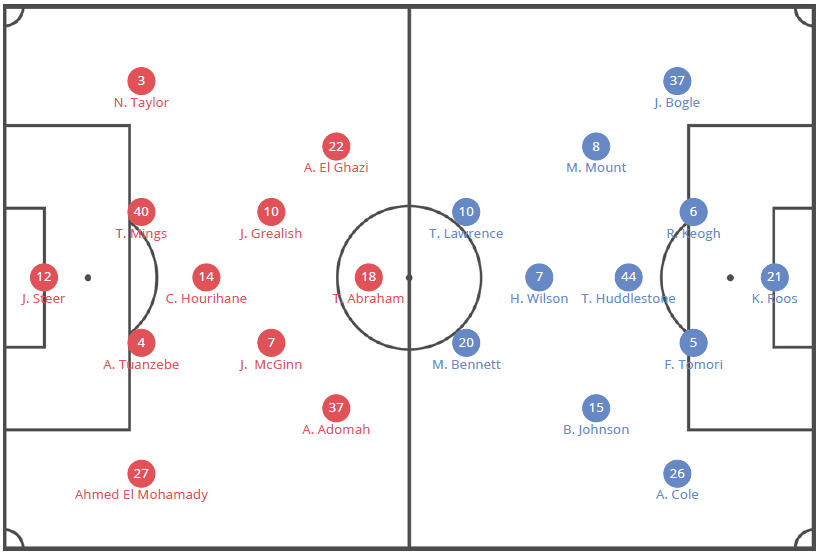
Lampard was a bit consistent in picking his starting lineup but he opted for a change in picking the formation, switching from a 4-2-3-1 into a 4-3-1-2. Mason Bennett and Tom Lawrence paired up as strikers. Harry Wilson was given the license to roam from his original attacking midfielder position. Other Chelsea loanees, Fikayo Tomori and Mason Mount, occupied the left centre-back and right central midfielder positions respectively.
Duane Holmes was a doubt ahead of the final and he picked Tom Huddlestone as his replacement. Scott Malone also missed out through suspension, with veteran defender Ashley Cole stepped up for his place. Martyn Waghorn managed to return from injury for a spot in the substitutes, alongside with Jack Marriott and Florian Jozefzoon.
Aston Villa’s defensive structure
When not in possession, Aston Villa tended to press the opposition players. But their press was conservative and they only began to press when the ball reached the middle third. This allowed the players to reshape the structure inside their own half and ready to defence.
The shot below demonstrated an example when Villa pressed. Abraham would put pressure on the centre-backs, forced them to play long passes or distribute wide. The midfield line was responsible for intercept any passes heading towards Derby’s midfielders. The wingers could also be active to run towards the full-backs and eliminate a passing option. Hourihane provided supports behind the line, covering any spaces that Derby players could utilise.
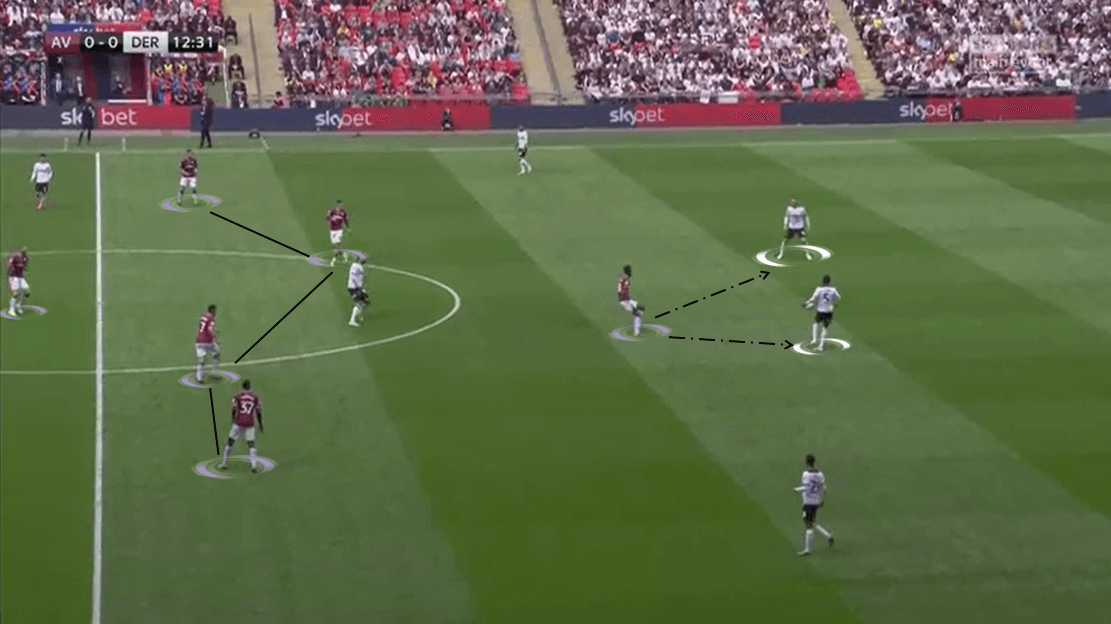
In the second half, the players usually created a pressure zone inside Derby’s half. While still keeping the press and do what mentioned above, they must be able to keep Derby’s midfielders in control. This zone was flexible and could be created with at least three Aston Villa players. The aim was to isolate as most passing options as possible, prevent the opposition from building attacks from the back.
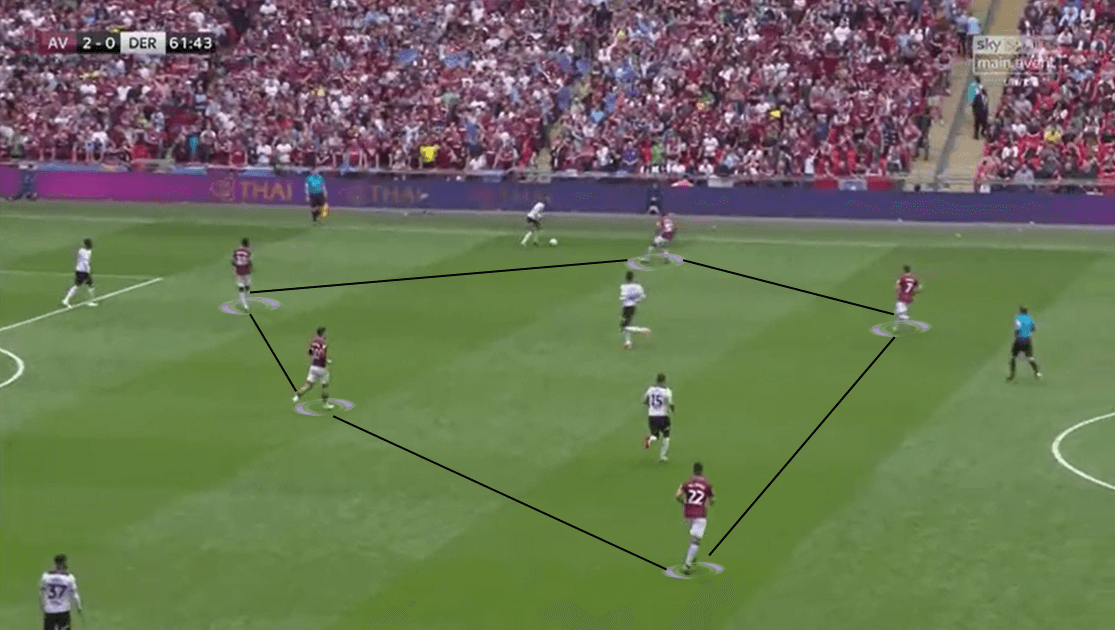
If the press was unsuccessful, Aston Villa would retreat into their own half and form a 4-1-4-1 defensive structure. This allowed them to create a low block in front of the 16-yard box and have numerical superiority to defend. The players tried to keep the distance between each other as narrow as possible. It would help them in providing cover for the surrounding teammates and prevent Derby from playing quick combinations between the lines.
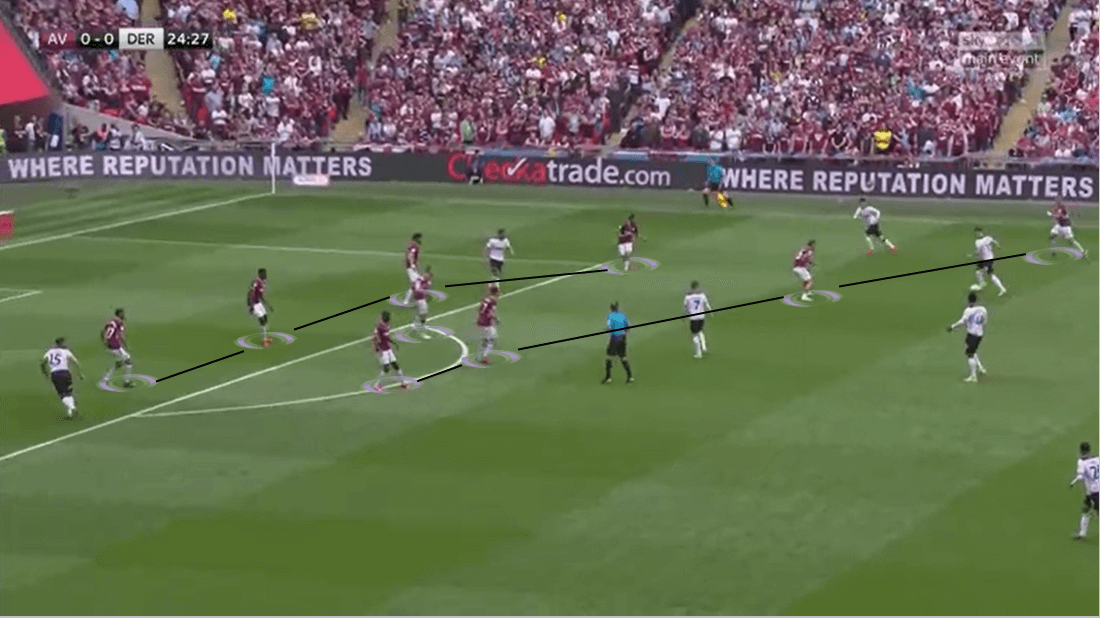
This defensive structure had proven its efficiency as Derby remained struggled throughout the game. Before the 70th minute, the away side could only register three shots and only one was on target. Another stat that contributed to Aston Villa’s superiority in defence was their number of interceptions. In total, they made 30 interceptions and 60% of them came inside their third.
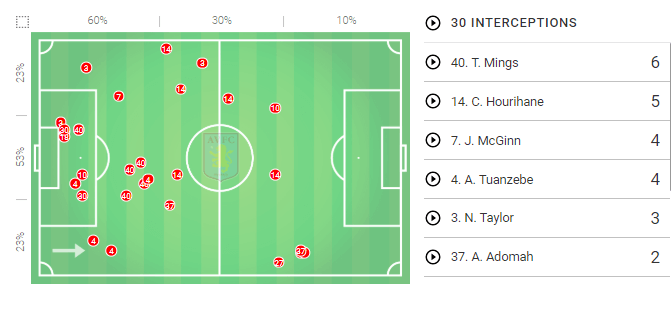
Two decisive moments for Aston Villa
In attack, Smith’s side tended to utilise the space behind Derby’s defensive line. Using pacey wingers and Abraham, they usually picked up the ball from the midfielders and beat their man with speed. Acknowledging that Cole wasn’t as quick as he used to, Smith encouraged Adomah to dribble whenever he had the ball. The same could be said about El Ghazi and he even made Jayden Bogle’s day worse. The English right-back usually struggled to catch up with El Ghazi because of the Dutch’s movement and pace.
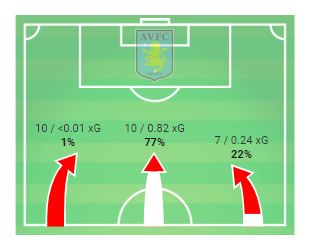
A similar situation happened and led to Aston Villa’s opening goal. Before picking up the ball from Hourihane, Adomah was in a free state and ready to make a run. Meanwhile, Abraham’s movement had attracted Tomori and Cole’s attention. The former Chelsea player knew that he couldn’t keep up with Adomah and decided to switch with Tomori.
That decision unintentionally created more time for both Adomah and Elmohamady to move into the right-hand side without being marked. The Egyptian defender picked the ball up and had all the time in the world to aim his cross. And it was Bogle’s leaky marking that allowed El Ghazi to move in and headed the ball into Kelle Roos’ net.
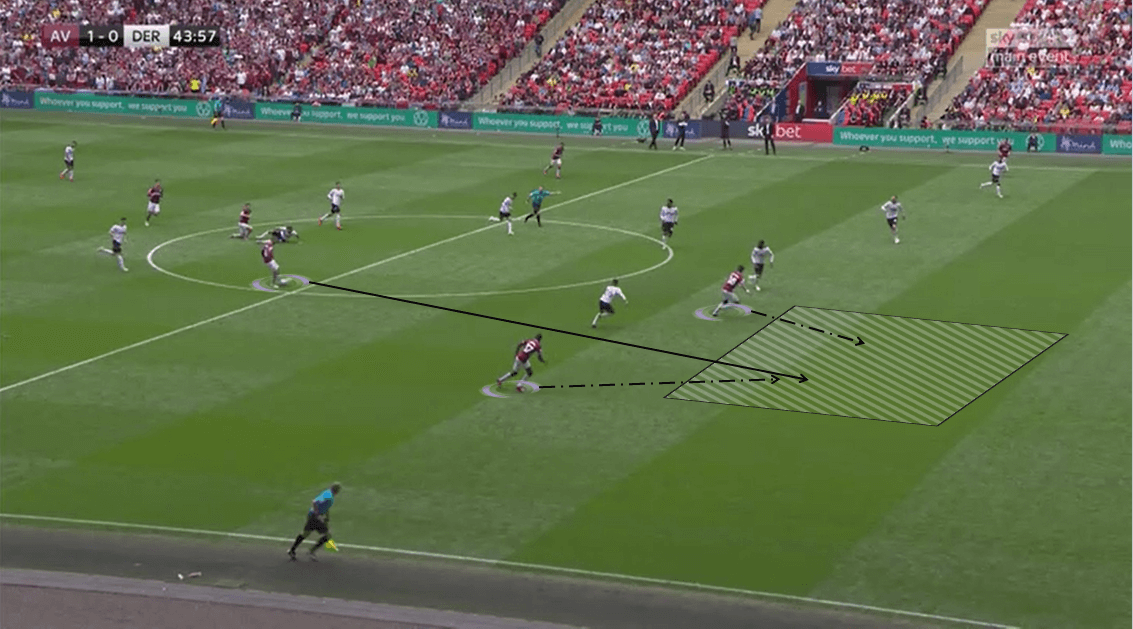
Aston Villa’s second goal of the game came from Derby’s individuals’ errors. First up, again, it was Bogle’s leaky marking that allowed El Ghazi to cut inside and take a shot. But it was Neil Taylor’s movement that created the space for the Dutch winger to attempt that. After laying the ball to El Ghazi, Taylor moved inside the box and that attracted Mount. The left winger immediately moved into that space and attempted a shot which was blocked by Richard Keogh.
The second error was Roos’ decision before McGinn’s header. In a situation where he could easily punch the ball out, he chose to claim the ball. But he went in late and missed the ball. Another thing could be said is McGinn went inside the box without being marked. Derby’s defenders were too focus on El Ghazi and they left the former Hibernian midfielder free.
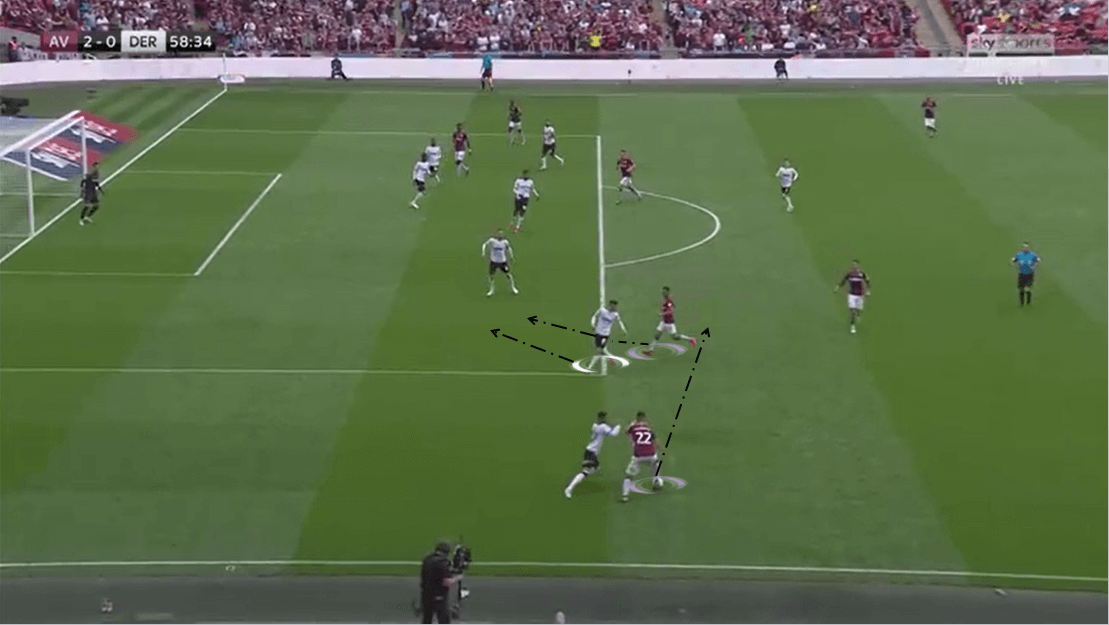
Derby’s style of play
It’s fair to say that Derby didn’t have such a bad game, at least on the defence perspective. Lampard’s side tended to play with a high defensive line and created a mid-block when the ball entered their half. The midfielders would create a shield in front of the defensive line, intercepting any vertical passes and through balls.
They intended to create a 4-4-2 defensive structure when out of possession but failed to do this. One of the factors that prevented Derby from creating the structure was Aston Villa’s quick transitions. Smith’s side usually plays direct passes to the attacking players and Derby didn’t have much time to retreat. In these situations, attacking midfielders like Wilson or Mount were located high up the pitch. When Derby lost the ball, they were still in the final third and couldn’t join the structure to defend against counter-attacks.
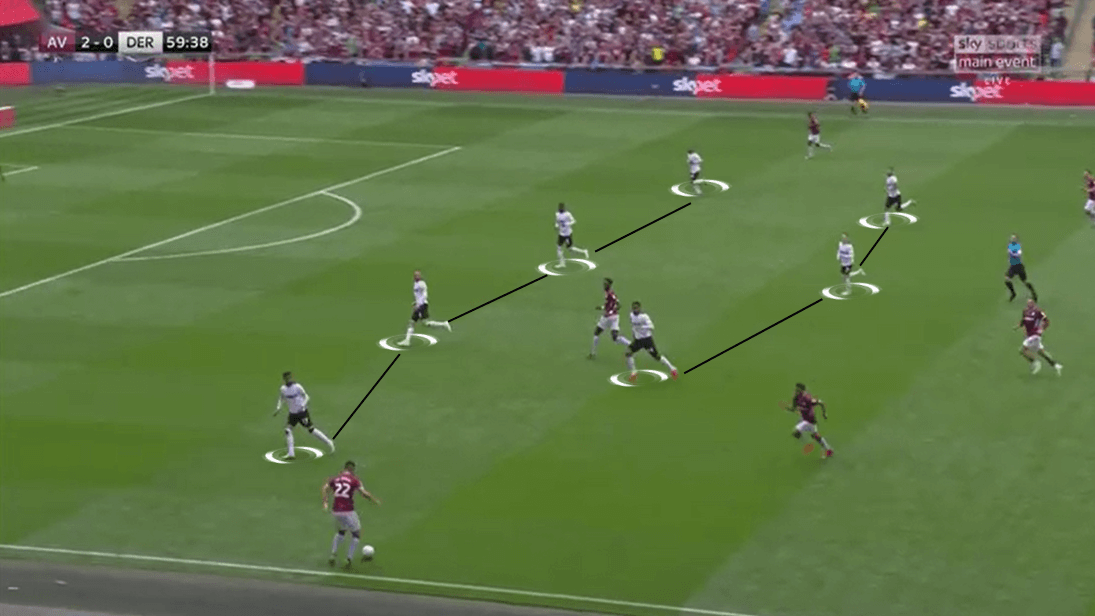
They also pressed very aggressively high up the pitch. When Aston Villa played out from the back, Bennett would put pressure on the ball-carrier and close him down. Meanwhile, Derby’s wingers would press the nearest full-back and centre-back. They aimed to limit the passing options that the ball-carrier had and forced him to play long balls. If either Hourihane or McGinn dropped deep for the ball, Mount would follow him and intercept any pass come towards.
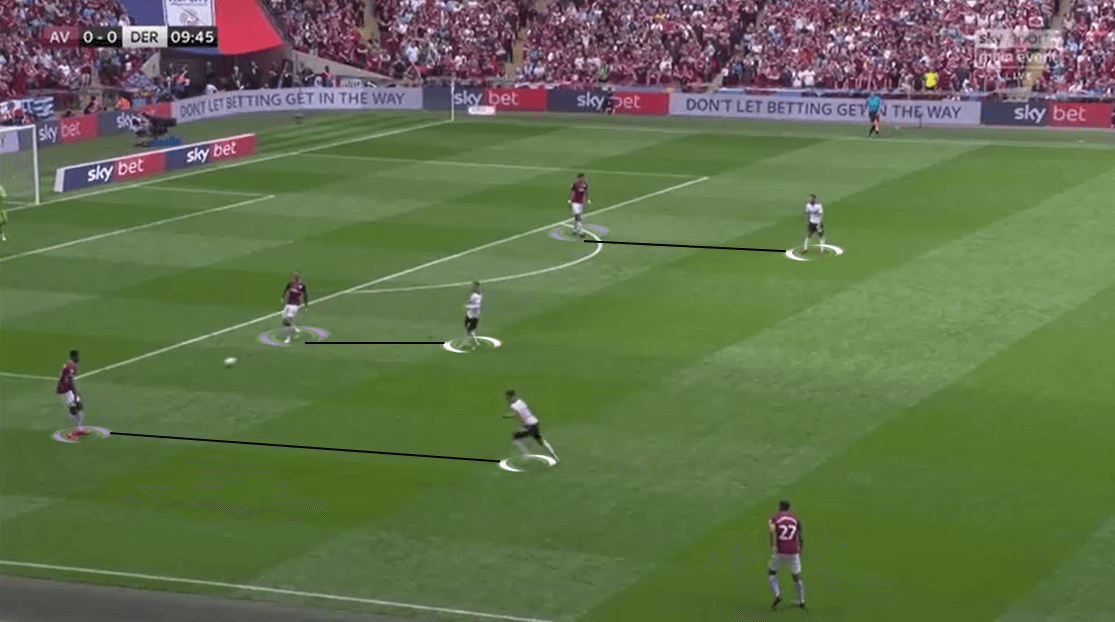
In attack, Derby weren’t good in creating chances. When Aston Villa lowered their tempo down, they had more opportunities to enter the box and came close to a goal in many occasions. The below situation is an example. Capitalised Aston Villa’s narrow defensive structure, Bogle made an overlap and received the ball from Mount. Unfortunately, the shot hit the side netting.
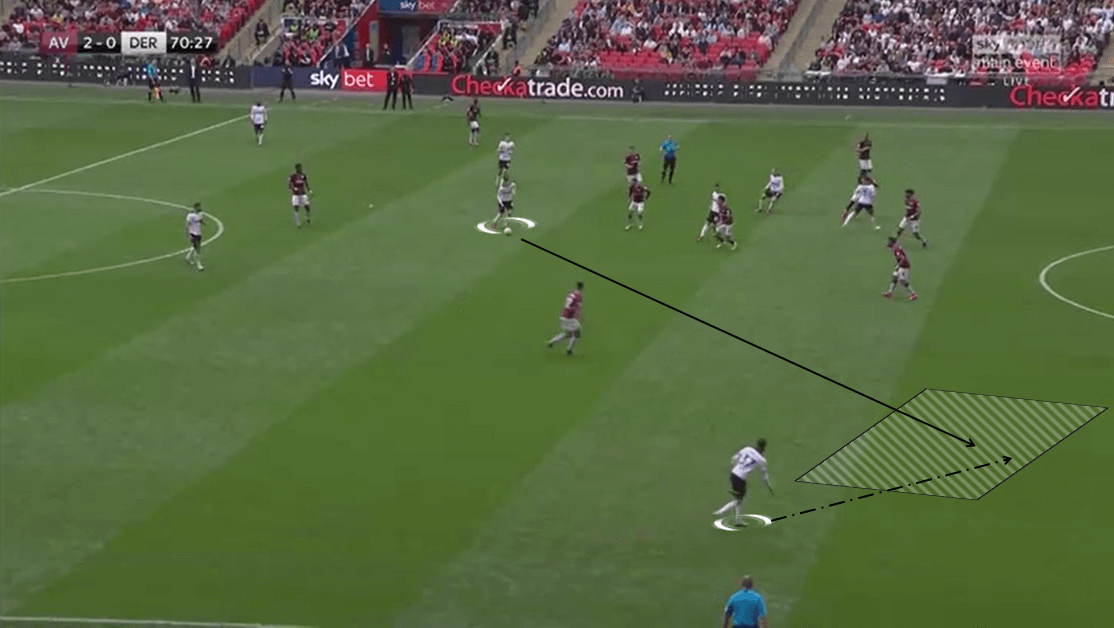
Around the last ten minutes, Derby had to play long, direct passes to limit the attacking time. And their efforts paid off at the 81st minute. When Waghorn was subbed on, he immediately left his impact on the field. He picked the ball up from Tomori and ran into the spaces behind Aston Villa’s defence.
Later, from a Jozefzoon’s cross, Bogle found himself in an active state and headed the ball to Marriott. The former Peterborough striker scored Derby’s consolation goal of the game. Derby also had many similar situations but Aston Villa’s defenders managed to stop those.
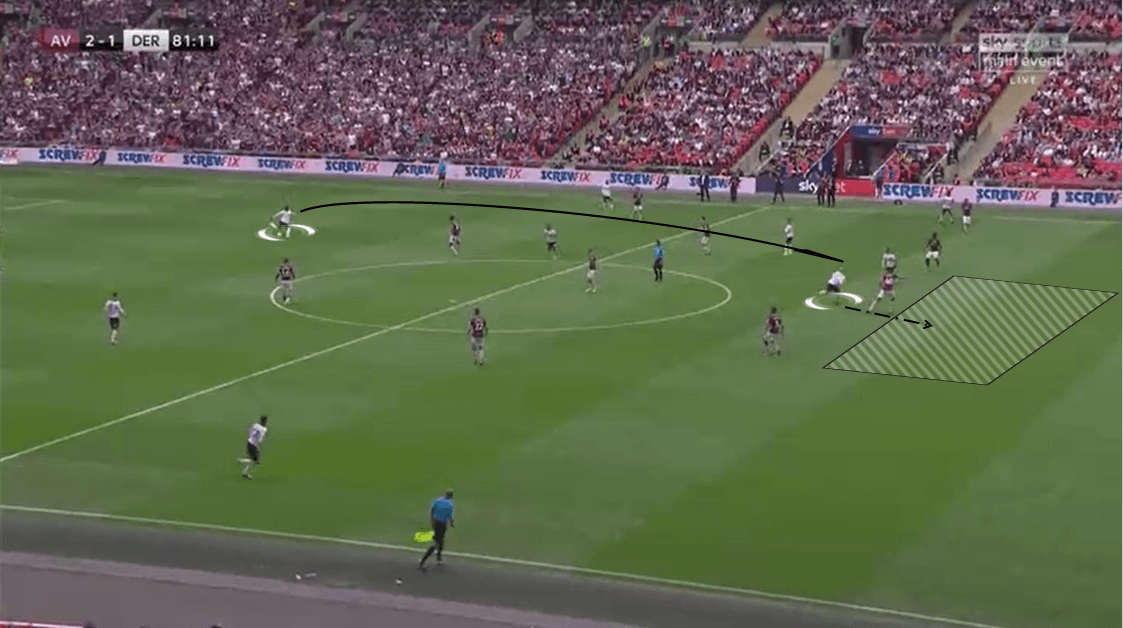
Conclusion
Aston Villa have ended their long wait for a promotion with a win against Derby. Under the management of a boyhood fan, Dean Smith, and the leadership of a loyal player, Jack Grealish, they finally reached the highest level of English football. This summer transfer window will be very crucial to them, with the amount of money they receive, they don’t want to be in the same state as Fulham and Huddersfield this season.
For Derby, they shouldn’t be so disheartened about this lost. They have finished a decent season with an attractive style of play. The only thing they should be worried about is how would they replace the loanees they have in the squad. Tomori, Wilson, Mount, they all play a very important part in Lampard’s formation. If they could keep the Chelsea legend on the sideline next season and with some more additions, a promotion spot could become a reality for them.
If you love tactical analysis, then you’ll love the digital magazines from totalfootballanalysis.com – a guaranteed 100+ pages of pure tactical analysis covering topics from the Premier League, Serie A, La Liga, Bundesliga and many, many more. Buy your copy of the May issue for just ₤4.99 here, or even better sign up for a ₤50 annual membership (12 monthly issues plus the annual review) right here.





Comments